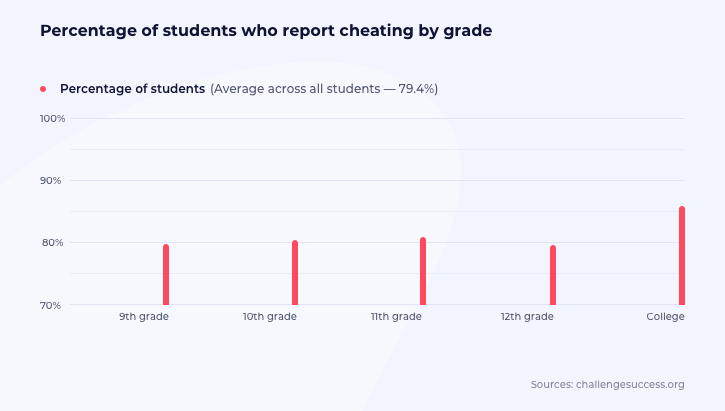The problem of academic dishonesty is growing at an enormous pace. Google alone gives over 261M results to the “how to cheat on a test” search request. And while some educators argue wholeheartedly that only trust to their students can actually inspire them to be as authentic in their study as the institution expects, others register unprecedentedly high levels of plagiarism in learners’ papers.
One way or another, the matter of academic misconduct is evolving, transforming, and gains new, unexpected edges that are definitely worth addressing.
Students’ motives to cheat
There is a variety of reasons that stimulate learners to resort to cheating in one way or another. But when analyzed in-depth, it’s getting clear that academia itself is the one that creates obstacles for students to then “overcome”.
Let’s break down what are the most distinguished causes of academic dishonesty among learners.
Focus on the final result over mastery
Being outdated and quite conservative in their ability to adapt, most educational systems still praise the final results aka grades over the actual student effort and knowledge in the field. This sends a very clear message to all of the learners out there: “We don’t care what you do during the semester, your paper/exam grade is what really matters”.
As a result, students just won’t be hustling for the whole period but rather do what they “should” on the exam to get that desired rank.
Heavy workloads
According to Challenge Success research, 59% of students claim they “have too much homework”, which is listed as one of the major sources of stress. As more and more educators demand to “do it all”, students feel justified to cheat for keeping up with the increasing burden of tasks and maintain their status in a success-focused environment.
Thus, 71% of students listed overall workload and homework as their major source of stress, 75% feel “often” or “always” stressed by their schoolwork, and 74% worry “quite a bit” or “a lot” about taking assessments.
International students
Coming from various backgrounds and having to deal with a great deal of cultural shock, it’s very hard for international students to keep up with the institution’s expectations in regard to academic integrity. First and foremost, language can be a problem, which pushes these students to resort to cheating to get a better grade and therefore, not being expelled.
With the growing number of Chinese students studying abroad, the phenomenon of their academic dishonesty and poor academic performance has been studied extensively in recent years.
No proper plagiarism-related education
At all times, students in the majority of educational institutions have had a very diverse understanding of academic integrity and plagiarism.
Yumin Gao, a senior studying engineering in Purdue University
No basic education on what’s considered plagiarism, how to cite material, and what the repercussions will be applied to those who neglect the rules leave freshmen with their own, predominantly intuitive, wisdom on the subject. For England, it resulted in 2,735 penalties issued to students in schools and colleges across the country in 2018.
Highly competitive academic and social environment
As achievement is deemed paramount in our society and Facebook posts like “Accepted to Harvard” collect hundreds of likes, 51% of learners feel the pressure to meet the expectations of their parents and 52% – to be accepted by their peers.
What’s more, the success-focused community has shaped a distinct notion in 57% of students that can be expressed as “successful people should do what they have to win, even if others consider it cheating”.
High achievers or so-called “grade-hungry students” are the product of this overwhelming pressure coming from every corner. They are especially prone to doing all it takes to get their highest grades and get praised by society.
Donald L. McCabe, a professor at the Rutgers University Business School, and a leading researcher on cheating.
Technology normalizes and simplifies cheating
With the rise of the Internet and open data availability, plagiarising has become the easiest endeavor ever. Having mobile, smartwatch, or an AI assistant at hand, it takes a couple of moments to take a photo or type in the correct answer and send it over to the friend. The majority of students won’t even recognize it as cheating. For those who do recognize and don’t want to share, there is always a working tool in place – peer pressure. The general manipulative idea is that friends should help each other out. If not, the person gets stigmatized and bullied among their mates, which represents that cheating is more normal than not.
Apart from that, there are numerous online services to help resolve math problems, translate from foreign languages, etc.
As a result, plagiarism rates in high school and universities have flourished to 79.4 and 86% accordingly. And only 12% of students indicated they would never cheat because of ethics.
 Forms of academic misconduct
Forms of academic misconduct
Ways of oversmarting instructor or university’s plagiarism solution are endless. Plagiarism has rightfully earned the reputation of the number one cheating method among students recently.
Other includes:
- Inheriting the whole course worth stack of papers from a relative/friend
- Assembling paper from various sources – mosaic plagiarism
- Copy-pasting material from the Internet
- Copying someone else’s homework
- Getting test answers or questions from someone else
- Working together on what was considered an individual task
Unauthorized collaboration, or when students work too closely together, is the most common case of academic dishonesty. About 40 percent of the 450 faculty who completed an academic integrity survey said inappropriate group collaboration occurs often or very often.
Jeff Stefancic, head of the Office of Student Rights and Responsibilities in Purdue University”
- Contract cheating – paying companies to write an essay for a student
- Tech-enabled cheating: using devices to discreetly store and utilize test answers; trying to oversmart plagiarism detection software – rewriting services, character replacement, inserting pictures with text, white symbols and chunks of text
Examples of now-popular high-tech cheating include the Golden High school and Thai medical school cases.
Strategies to prevent cheating
The issue of cheating has quite a long record and has seated in the minds of people for decades. We are positive that it can still be beaten effectively if preventive measures are taken seriously and consistently.
| Students | Instructors |
| Set the goal – why do you want to become well-educated | Instruct students on the rules and consequences of cheating |
| Find out your institution’s rules regarding plagiarism | Choose less generalized topics for essays |
| Focus on the process of gaining knowledge instead of the final grade | Use plagiarism prevention solution |
| Learn to work on a paper from scratch | Create multiple versions of the exam |
| Learn to attribute sources and assemble bibliography properly | Prohibit gadgets |
| Initiate meetings with your teacher to clarify arguable aspects as you work on an assignment | Proctor exams |
| Emphasize the value of mastery and learning over performance |
Tips to minimize tech-enabled cheating
Electronic, digital or high-tech cheating has become the real scourge of our times. Even though it can seem impossible to eradicate this type of cheating simply because there are gadgets everywhere, it’s not as bad.
There are two main strategies with this – either to restrict gadgets as much as possible during tests or incorporate various tools to check for plagiarism, proctor exams, and more.
Like with the California State University, where among these basic techniques they also try to design courses together with students to better align these with their needs and interests.
Others go even further, like at Rudgers, where they fly their staff to the countries of origin of their future students to educate them on the university’s standards before the school year even begins.





